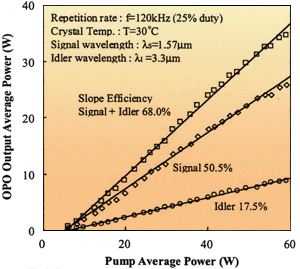CLEO 2000 Postdeadline: OPO provides high-power operation at room temperature
By: Yvonne Carts-Powell
An optical parametric oscillator (OPO) made using a 1-mm-thick periodically poled magnesium-doped lithium niobate (PPMgLN) operated in singly resonant mode, and emitted a total average power of 35 W at 1.57 and 3.3 µ, with slope efficiencies up to 68% (see Figure 1).

At the postdeadline paper session at the Conference on Lasers and Electro-Optics (CLEO 2000; San Francisco, CA; May 7-12), Y. Hirano at <%=company%> (Kamakura, Kanagawa, Japan) and coworkers at Mitsubishi and the National Institute for Research in Organic Materials (NIRIM, Tukuba, Japan) reported building and testing the PPMgLN OPO.1
Adding magnesium
Periodically poled nonlinear materials are attractive because they can be used to convert wavelengths efficiently, providing users with a widely tunable IR laser source. Among these materials, periodically poled lithium niobate (PPLN) has been particularly successful because of its large effective nonlinear coefficient and the large range of wavelengths that can be obtained from it. To avoid damaging the nonlinear material, users heat it to around 100° C, which increases the complexity and size of the OPO.
To skirt this issue, researchers have instead increased the material's toughness by doping it with magnesium. The resulting device worked at room temperature. The main advantage of this, Douglas Bamford, of Gemfire Corp. (Palo Alto, CA) explains, is that "you don't have to put the crystal in an oven."
Device design
Another power-limiting factor in PPLN OPOs is the relatively small aperture. To ease this restraint, the researchers designed the system with a 1 mm2 aperture. A linearly polarized, Q-switched Nd:YAG laser provided the pump power in a beam was weakly focused to a 0.4-mm-diameter spot at the center of the device. The cavity length of the OPO was 60-mm. The 30-mm-long nonlinear material was poled with a period of 30.8 µm.
When pumped by 73-ns-long pulses at a 120 kHz pulse repetition rate, the OPO produced a signal wavelength at 1.57 µm with a 50.5% efficiency and an idler wavelength at 3.3 µm with a slope efficiency of 17.5 µm. The researchers note that no bulk or surface damage occurred at the pump peak power density of 49 MW/cm2.
Reference
1. Y. Hirano et al, "High-Average Power, Room Temperature Operation of PPMgLN OPO", CLEO 2000 postdeadline paper #CPD7, San Francisco, CA (2000).
